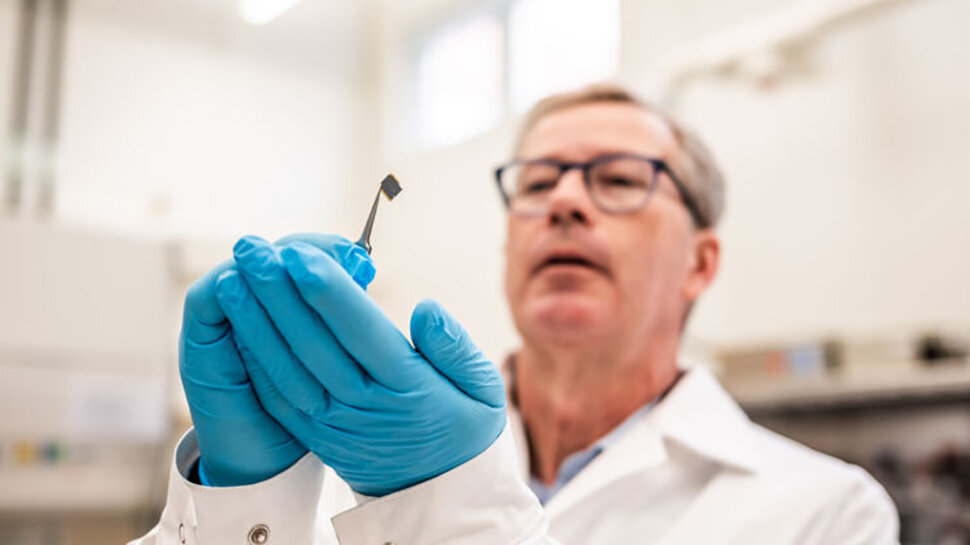Search the Community
Showing results for tags 'research'.
-
Described by Nature as the “gilded cousin of Graphene”, Goldene is a one-atom-thick sheet of gold created by scientists from Linköping University (LiU) in Sweden. It has unique properties that the researchers believe could pave the way for applications such as carbon dioxide conversion, hydrogen production, water purification, and communication. Shun Kashiwaya, a researcher at the Materials Design Division at LiU, explains, "If you make a material extremely thin, something extraordinary happens. As with Graphene, the same thing happens with gold. As you know, gold is usually a metal, but if single-atom-layer thick, the gold can become a semiconductor instead." An accidental discovery Historically, attempts to create single-atom sheets of gold have been hindered due to the metal’s propensity to lump together. However, the successful creation of Goldene was achieved via a century-old Japanese smithing technique called Murakami’s reagent, which etches away carbon residue. For this task the team used an oxidizing reagent. To produce Goldene, the researchers used a three dimensional base material with layers of gold sandwiched between titanium and carbon. There was an element of serendipity to the creation of Goldene however, as Lars Hultman, professor of thin film physics at LiU admits. “We had created the base material with completely different applications in mind. We started with an electrically conductive ceramics called titanium silicon carbide, where silicon is in thin layers. Then the idea was to coat the material with gold to make a contact. But when we exposed the component to high temperature, the silicon layer was replaced by gold inside the base material.” The LiU researchers now plan to turn their attention to exploring whether other noble metals could undergo a similar process and yield yet more unimaginable applications. Funding for this research was provided by a range of institutions, including the Swedish Research Council, the Swedish Government's Strategic Research Area in Materials Science, and Linköping University. More from TechRadar Pro Future computers will have chips made with exotic materialsScientists inch closer to holy grail of memory breakthroughScientists build a silicon-less computer that use light waves View the full article
-
Apple researchers have developed an artificial intelligence system named ReALM (Reference Resolution as Language Modeling) that aims to radically enhance how voice assistants understand and respond to commands. In a research paper (via VentureBeat), Apple outlines a new system for how large language models tackle reference resolution, which involves deciphering ambiguous references to on-screen entities, as well as understanding conversational and background context. As a result, ReALM could lead to more intuitive and natural interactions with devices. Reference resolution is an important part of natural language understanding, enabling users to use pronouns and other indirect references in conversation without confusion. For digital assistants, this capability has historically been a significant challenge, limited by the need to interpret a wide range of verbal cues and visual information. Apple's ReALM system seeks to address this by converting the complex process of reference resolution into a pure language modeling problem. In doing so, it can comprehend references to visual elements displayed on a screen and integrate this understanding into the conversational flow. ReALM reconstructs the visual layout of a screen using textual representations. This involves parsing on-screen entities and their locations to generate a textual format that captures the screen's content and structure. Apple researchers found that this strategy, combined with specific fine-tuning of language models for reference resolution tasks, significantly outperforms traditional methods, including the capabilities of OpenAI's GPT-4. ReALM could enable users to interact with digital assistants much more efficiently with reference to what is currently displayed on their screen without the need for precise, detailed instructions. This has the potential to make voice assistants much more useful in a variety of settings, such as helping drivers navigate infotainment systems while driving or assisting users with disabilities by providing an easier and more accurate means of indirect interaction. Apple has now published several AI research papers. Last month, the company revealed a new method for training large language models that seamlessly integrates both text and visual information. Apple is widely expected to unveil an array of AI features at WWDC in June.Tag: Artificial Intelligence This article, "Apple Researchers Reveal New AI System That Can Beat GPT-4" first appeared on MacRumors.com Discuss this article in our forums View the full article
-
The State of Open Source Security Highlights Many Organizations Lacking Strategies to Address Application Vulnerabilities Arising from Code Reuse BOSTON — June 21, 2022 — Snyk, the leader in developer security, and The Linux Foundation, a global nonprofit organization enabling innovation through open source, today announced the results of their first joint research report, The State of Open Source Security. The results detail the significant security risks resulting from the widespread use of open source software within modern application development as well as how many organizations are currently ill-prepared to effectively manage these risks. Specifically, the report found: Over four out of every ten (41%) organizations don’t have high confidence in their open source software security; The average application development project has 49 vulnerabilities and 80 direct dependencies (open source code called by a project); and, The time it takes to fix vulnerabilities in open source projects has steadily increased, more than doubling from 49 days in 2018 to 110 days in 2021. “Software developers today have their own supply chains – instead of assembling car parts, they are assembling code by patching together existing open source components with their unique code. While this leads to increased productivity and innovation, it has also created significant security concerns,” said Matt Jarvis, Director, Developer Relations, Snyk. “This first-of-its-kind report found widespread evidence suggesting industry naivete about the state of open source security today. Together with The Linux Foundation, we plan to leverage these findings to further educate and equip the world’s developers, empowering them to continue building fast, while also staying secure.” “While open source software undoubtedly makes developers more efficient and accelerates innovation, the way modern applications are assembled also makes them more challenging to secure,” said Brian Behlendorf, General Manager, Open Source Security Foundation (OpenSSF). “This research clearly shows the risk is real, and the industry must work even more closely together in order to move away from poor open source or software supply chain security practices.” (You can read the OpenSSF’s blog post about the report here) Snyk and The Linux Foundation will be discussing the report’s full findings as well as recommended actions to improve the security of open source software development during a number of upcoming events: Session at Open Source Summit North America in Austin, TX, titled, “Addressing Cybersecurity Challenges in Open Source Software,” taking place Tuesday, June 21, at 12 p.m. local time (CT). Webinar taking place Tuesday, June 28, at 1 p.m. ET, to register, visit here. Webinar taking place Wednesday, June 29, at 9 a.m. ET, to register, visit here. 41% of Organizations Don’t Have High Confidence in Open Source Software Security Modern application development teams are leveraging code from all sorts of places. They reuse code from other applications they’ve built and search code repositories to find open source components that provide the functionality they need. The use of open source requires a new way of thinking about developer security that many organizations have not yet adopted. Further consider: Less than half (49%) of organizations have a security policy for OSS development or usage (and this number is a mere 27% for medium-to-large companies); and, Three in ten (30%) organizations without an open source security policy openly recognize that no one on their team is currently directly addressing open source security. Average Application Development Project: 49 Vulnerabilities Spanning 80 Direct Dependencies When developers incorporate an open source component in their applications, they immediately become dependent on that component and are at risk if that component contains vulnerabilities. The report shows how real this risk is, with dozens of vulnerabilities discovered across many direct dependencies in each application evaluated. This risk is also compounded by indirect, or transitive, dependencies, which are the dependencies of your dependencies. Many developers do not even know about these dependencies, making them even more challenging to track and secure. That said, to some degree, survey respondents are aware of the security complexities created by open source in the software supply chain today: Over one-quarter of survey respondents noted they are concerned about the security impact of their direct dependencies; Only 18% of respondents said they are confident of the controls they have in place for their transitive dependencies; and, Forty percent of all vulnerabilities were found in transitive dependencies. Time to Fix: More Than Doubled from 49 Days in 2018 to 110 Days in 2021 As application development has increased in complexity, the security challenges faced by development teams have also become increasingly complex. While this makes development more efficient, the use of open source software adds to the remediation burden. The report found that fixing vulnerabilities in open source projects takes almost 20% longer (18.75%) than in proprietary projects. About The Report The State of Open Source Security is a partnership between Snyk and The Linux Foundation, with support from OpenSSF, the Cloud Native Security Foundation, the Continuous Delivery Foundation and the Eclipse Foundation. The report is based on a survey of over 550 respondents in the first quarter of 2022 as well as data from Snyk Open Source, which has scanned more than 1.3B open source projects. About Snyk Snyk is the leader in developer security. We empower the world’s developers to build secure applications and equip security teams to meet the demands of the digital world. Our developer-first approach ensures organizations can secure all of the critical components of their applications from code to cloud, leading to increased developer productivity, revenue growth, customer satisfaction, cost savings and an overall improved security posture. Snyk’s Developer Security Platform automatically integrates with a developer’s workflow and is purpose-built for security teams to collaborate with their development teams. Snyk is used by 1,500+ customers worldwide today, including industry leaders such as Asurion, Google, Intuit, MongoDB, New Relic, Revolut, and Salesforce. About The Linux Foundation The Linux Foundation is the organization of choice for the world’s top developers and companies to build ecosystems that accelerate open technology development and commercial adoption. Together with the worldwide open source community, it is solving the hardest technology problems by creating the largest shared technology investment in history. Founded in 2000, The Linux Foundation today provides tools, training and events to scale any open source project, which together deliver an economic impact not achievable by any one company. More information can be found at www.linuxfoundation.org. The post New Research from Snyk and The Linux Foundation Reveals Significant Security Concerns Resulting from Open Source Software Ubiquity appeared first on Linux Foundation. The post New Research from Snyk and The Linux Foundation Reveals Significant Security Concerns Resulting from Open Source Software Ubiquity appeared first on Linux.com. View the full article
-
- snyk
- linux foundation
-
(and 3 more)
Tagged with:
-
Forum Statistics
73.8k
Total Topics71.7k
Total Posts
.png.6dd3056f38e93712a18d153891e8e0fc.png.1dbd1e5f05de09e66333e631e3342b83.png.933f4dc78ef5a5d2971934bd41ead8a1.png)


